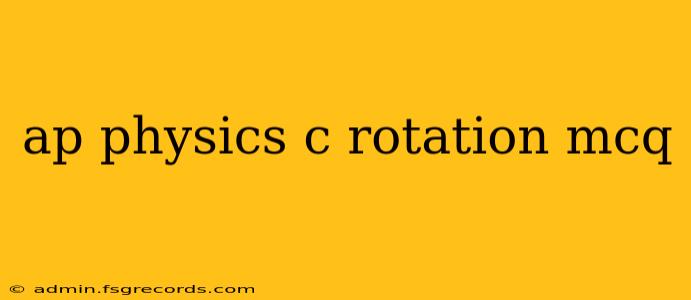The AP Physics C: Mechanics exam's rotation section can be challenging. Many students find rotational motion concepts more difficult to grasp than linear motion. This post dives deep into tackling multiple-choice questions (MCQs) on rotation, equipping you with strategies and key concepts to improve your score.
Understanding the Fundamentals of Rotational Motion
Before tackling MCQs, let's review the essential concepts:
1. Angular Quantities:
- Angular Displacement (θ): Measured in radians, representing the angle through which an object rotates.
- Angular Velocity (ω): The rate of change of angular displacement (dθ/dt), measured in radians per second (rad/s).
- Angular Acceleration (α): The rate of change of angular velocity (dω/dt), measured in radians per second squared (rad/s²).
These quantities are analogous to linear displacement, velocity, and acceleration, but they describe rotational motion. Remember the relationships between them: ω = dθ/dt and α = dω/dt.
2. Rotational Kinematics:
Rotational kinematics equations are analogous to linear kinematics equations. They relate angular displacement, velocity, and acceleration. Familiarize yourself with these equations:
- θ = ωᵢt + ½αt²
- ωf = ωᵢ + αt
- ωf² = ωᵢ² + 2αθ
Where:
- θ = angular displacement
- ωᵢ = initial angular velocity
- ωf = final angular velocity
- α = angular acceleration
- t = time
3. Moment of Inertia (I):
The moment of inertia is the rotational equivalent of mass. It represents an object's resistance to changes in its rotational motion. It depends on the object's mass distribution and its axis of rotation. Knowing the moment of inertia formulas for common shapes (e.g., solid cylinder, thin hoop, solid sphere) is crucial.
4. Torque (τ):**
Torque is the rotational equivalent of force. It causes an object to rotate. It's calculated as:
τ = rFsinθ
where:
- τ = torque
- r = distance from the axis of rotation to the point where the force is applied
- F = force
- θ = angle between the force vector and the lever arm (r)
5. Newton's Second Law for Rotation:
This law states that the net torque acting on an object is equal to the product of its moment of inertia and its angular acceleration:
τnet = Iα
This is analogous to Newton's second law for linear motion (Fnet = ma).
Strategies for Tackling AP Physics C Rotation MCQs
-
Draw Diagrams: Visualizing the problem with a clear diagram is essential. Draw the object, indicate the forces acting on it, and label relevant distances and angles.
-
Identify the Knowns and Unknowns: Carefully list what information is given and what needs to be found.
-
Choose the Right Equations: Based on the knowns and unknowns, select the appropriate rotational kinematics or dynamics equations.
-
Check Units: Always ensure your units are consistent (radians, kilograms, meters, seconds). Inconsistencies are a common source of errors.
-
Eliminate Incorrect Answers: If you're unsure of the correct answer, try eliminating unlikely options based on your understanding of the concepts.
-
Practice Regularly: Solving numerous practice problems is key to mastering rotational motion. Utilize past AP Physics C exams and practice books.
Example MCQ and Solution Approach
Question: A solid cylinder of mass M and radius R rolls without slipping down an inclined plane. What is its acceleration down the plane?
(A) gsinθ (B) (2/3)gsinθ (C) (1/2)gsinθ (D) (1/3)gsinθ
Solution Approach:
-
Diagram: Draw the cylinder on the inclined plane, showing the forces acting on it (gravity, normal force, friction).
-
Knowns and Unknowns: Knowns include mass (M), radius (R), acceleration due to gravity (g), and angle of inclination (θ). The unknown is the acceleration down the plane.
-
Equations: We'll use Newton's second law for linear and rotational motion, along with the rolling without slipping condition (v = ωR, a = αR).
-
Solution: Applying Newton's second law and the rolling without slipping condition leads to the solution (B) (2/3)gsinθ. The detailed derivation involves considering both translational and rotational motion.
By mastering these fundamentals and employing these strategies, you'll significantly improve your ability to solve AP Physics C rotation MCQs effectively and confidently. Remember that consistent practice is the key to success.

